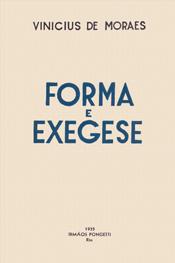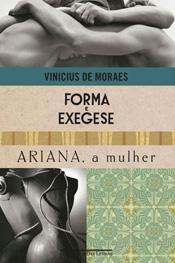backBooks of Poetry
Forma e Exegese (Form and exegesis)
Rio de Janeiro, Pongetti, 1935
Form and Exegesis marks the continuity of Vinicius de Moraes’s poet career. He was still 22 years old, and it was the second book of the young man who, even so, clung to the Symbolism as a beloved school while writing verses or choosing themes. The various dedications of the book to Arthur Rimbaud, Mallarmé, Claudel or Jacques Riviére, seal the alliance of the young poet with his French literary matrix and shows us the poetic affiliation which Vinicius still cultivated.
Despite the attachment to the symbolist universe and its connection with the Catholic intellectual milieu of Rio de Janeiro, the book presents some first steps in broader poetic conjectures of the author. Poems like "Ilha do Governador” (Governor's Island), about his childhood in this neighborhood of Rio de Janeiro, or "A Volta da Mulher Morena” (The Return of the Brunette) stand out from the long verses about death, virgins, ecstasies, God and all the mystical aura that emanates from most of its pages. They now point to a Vinicius who would glimpse not only pain but also pleasure and light on themes related to his hometown and the woman, the main motto of his later poetry.
Form and Exegesis was a clear step ahead of the young poet in relation to his first book and managed to gain prominence in the literary milieu of that period. Even without having, by that time, the friendship he would make throughout life, he publicly receives positive reviews from a then already mature Manuel Bandeira. With the book, Vinicius wins the prestigious prize Filipe d'Oliveira.
Despite the attachment to the symbolist universe and its connection with the Catholic intellectual milieu of Rio de Janeiro, the book presents some first steps in broader poetic conjectures of the author. Poems like "Ilha do Governador” (Governor's Island), about his childhood in this neighborhood of Rio de Janeiro, or "A Volta da Mulher Morena” (The Return of the Brunette) stand out from the long verses about death, virgins, ecstasies, God and all the mystical aura that emanates from most of its pages. They now point to a Vinicius who would glimpse not only pain but also pleasure and light on themes related to his hometown and the woman, the main motto of his later poetry.
Form and Exegesis was a clear step ahead of the young poet in relation to his first book and managed to gain prominence in the literary milieu of that period. Even without having, by that time, the friendship he would make throughout life, he publicly receives positive reviews from a then already mature Manuel Bandeira. With the book, Vinicius wins the prestigious prize Filipe d'Oliveira.
Bibliographical Note
Na Poesia completa e Prosa editada pela Nova Aguilar (1ª ed. 1968; 2ª ed. 1974), este livro aparece agrupado com outros dois (O caminho para a distância e Ariana, a mulher), sob um título (denominado "epífrafe") único: O sentimento do sublime. O responsável por tal organização foi o professor e crítico Afrânio Coutinho (1911-2000), com a concordância de Vinicius de Moraes. Neste site, o usuário pode acessar os livros pelos seus títulos originais - conforme as edições anteriores à reunião em volume pela Nova Aguilar.
Forma e exegese foi publicado em 1935 (Rio de Janeiro: Irmãos Pongetti), 173 p. A epígrafe do volume é de J. Rivière - "Je ne vois clair qu'au contact de la vie." e é dedicado a Jean-Arthur Rimbaud e Jacques Rivière.
O livro é dividido em 5 partes:
I - (De "O olhar para trás" a "Ausência" - poemas de 1 a 6)
Epígrafe de León Bloy: "Souffrir passe, avoir souffert ne passe jamais."
II - (De "O incriado" a "Agonia" - poemas de 7 a 12)
Epígrafe de uma carta de Mário Vieira de Mello: "Deus existe, eu é que não existo.", e de Mallarmé: "- Le Ciel est mort. - Vers toi, j'accours! donne, ô matière.".
III - (De "A legião dos Úrias" a "A música das almas" - poemas de 13 a 19)
Epígrafe de Goethe: "Todo o efêmero não é senão símbolo.", e de Rimbaud: "… j'ai vu quelquefois ce que l'homme a cru voir.".
IV - (De "O bergantim da aurora" a "A lenda da maldição" - poemas de 20 a 24)
Epígrafe de Rimbaud: "Mais, vrai, j'ai trop pleuré. Les aubes sont navrantes / Toute lune est atroce et tout soleil amer.".
V - (Composta pelas três partes do poema "Os malditos")
Epígrafe de Rimbaud: "Assez! voici la punition: - En Marche!".
Forma e exegese foi publicado em 1935 (Rio de Janeiro: Irmãos Pongetti), 173 p. A epígrafe do volume é de J. Rivière - "Je ne vois clair qu'au contact de la vie." e é dedicado a Jean-Arthur Rimbaud e Jacques Rivière.
O livro é dividido em 5 partes:
I - (De "O olhar para trás" a "Ausência" - poemas de 1 a 6)
Epígrafe de León Bloy: "Souffrir passe, avoir souffert ne passe jamais."
II - (De "O incriado" a "Agonia" - poemas de 7 a 12)
Epígrafe de uma carta de Mário Vieira de Mello: "Deus existe, eu é que não existo.", e de Mallarmé: "- Le Ciel est mort. - Vers toi, j'accours! donne, ô matière.".
III - (De "A legião dos Úrias" a "A música das almas" - poemas de 13 a 19)
Epígrafe de Goethe: "Todo o efêmero não é senão símbolo.", e de Rimbaud: "… j'ai vu quelquefois ce que l'homme a cru voir.".
IV - (De "O bergantim da aurora" a "A lenda da maldição" - poemas de 20 a 24)
Epígrafe de Rimbaud: "Mais, vrai, j'ai trop pleuré. Les aubes sont navrantes / Toute lune est atroce et tout soleil amer.".
V - (Composta pelas três partes do poema "Os malditos")
Epígrafe de Rimbaud: "Assez! voici la punition: - En Marche!".

